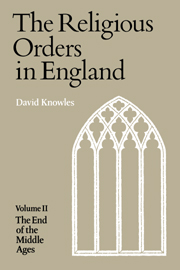Book contents
- Frontmatter
- Contents
- Preface
- List of Abbreviations
- Part One The Historical Framework
- Chap. I The opening of the period
- Chap. II Monks and canons at the university, 130c–1450
- Chap. III Patrons and architects: Ely and Gloucester
- Chap. IV Portraits of monks
- Chap. V Monks and friars in controversy
- Chap. VI Trends in speculation: Ockhamism, justification and grace
- Chap. VII Criticism of the religious in the fourteenth century
- Chap. VIII The spiritual life of the fourteenth century
- Chap. IX Developments within the orders: I
- Chap. X Developments within the orders: II
- Chap. XI The fortunes of the Cluniac houses and the alien priories
- Chap. XII The loosening of discipline
- Chap. XIII King Henry V
- Chap. XIV More portraits of monks
- Chap. XV The second century of visitation, 1350–1450
- Chap. XVI The spiritual life of the fifteenth century
- Part Two The Institutional Background
- Appendix I Chaucer's monk
- Appendix II Henry V and the Westminster recluse
- Appendix III Regulars as bishops
- Bibliography
- Index
Chap. I - The opening of the period
Published online by Cambridge University Press: 28 January 2010
- Frontmatter
- Contents
- Preface
- List of Abbreviations
- Part One The Historical Framework
- Chap. I The opening of the period
- Chap. II Monks and canons at the university, 130c–1450
- Chap. III Patrons and architects: Ely and Gloucester
- Chap. IV Portraits of monks
- Chap. V Monks and friars in controversy
- Chap. VI Trends in speculation: Ockhamism, justification and grace
- Chap. VII Criticism of the religious in the fourteenth century
- Chap. VIII The spiritual life of the fourteenth century
- Chap. IX Developments within the orders: I
- Chap. X Developments within the orders: II
- Chap. XI The fortunes of the Cluniac houses and the alien priories
- Chap. XII The loosening of discipline
- Chap. XIII King Henry V
- Chap. XIV More portraits of monks
- Chap. XV The second century of visitation, 1350–1450
- Chap. XVI The spiritual life of the fifteenth century
- Part Two The Institutional Background
- Appendix I Chaucer's monk
- Appendix II Henry V and the Westminster recluse
- Appendix III Regulars as bishops
- Bibliography
- Index
Summary
THE BENEDICTINE CONSTITUTIONS
The constitutional and capitular history of the black monks between the Fourth Lateran Council and the Dissolution is divided conveniently, if somewhat accidentally, by the constitutions issued in 1336 by Benedict XII. That pontiff, who reigned from the last days of 1334 to the spring of 1342, was in many ways the most distinguished of the popes of the fourteenth century after the death of Boniface VIII, and his comparatively short reign left a permanent mark both on church discipline and the history of dogma, while a more tangible monument of his energies remains in the massive ochre walls of the Palace of the Popes at Avignon. Himself a French Cistercian who had ruled as abbot before his elevation to the episcopate, he earnestly worked as pope for such a reform or reorganization of the monastic and religious orders as should be in harmony with the ideas of the time. He was a practical and energetic ruler, and within five years of his accession had accomplished a large part of his task, as he saw it, by preparing and promulgating comprehensive statutes for the three great orders of monks and canons. His first care was to issue a bull (Pastorbonus of 17 June 1335) against apostate religious; this was followed by constitutions for his own order in Fulgens sicut stella of 12 July; then came the decrees for the black monks in Summi magistri of 20 June 1336; and finally the Augustinian canons received the Ad decorem of 15 May 1339.
- Type
- Chapter
- Information
- Religious Orders Vol 2 , pp. 3 - 13Publisher: Cambridge University PressPrint publication year: 1979



